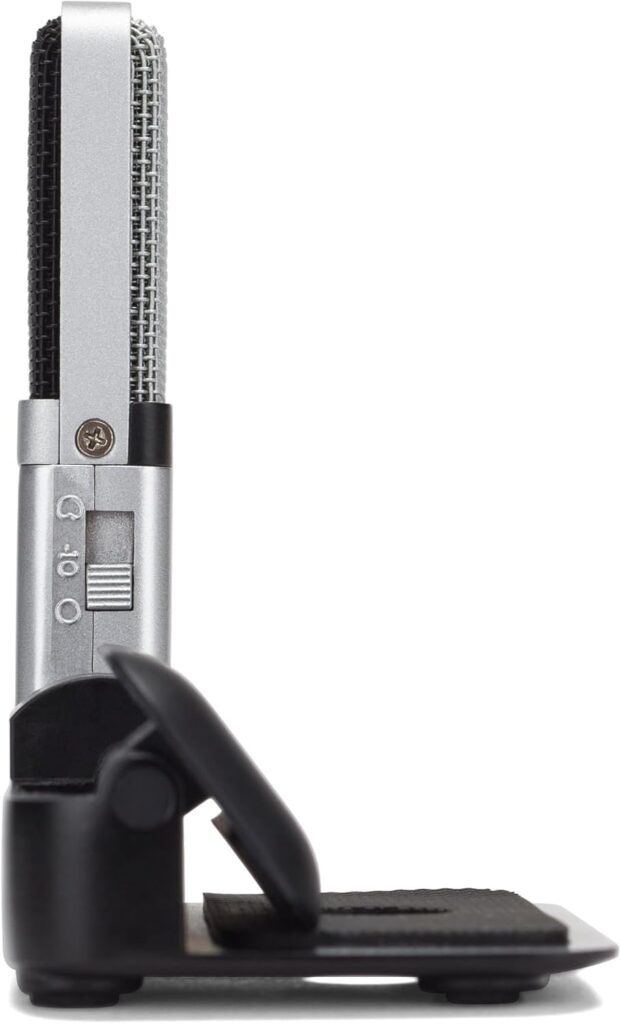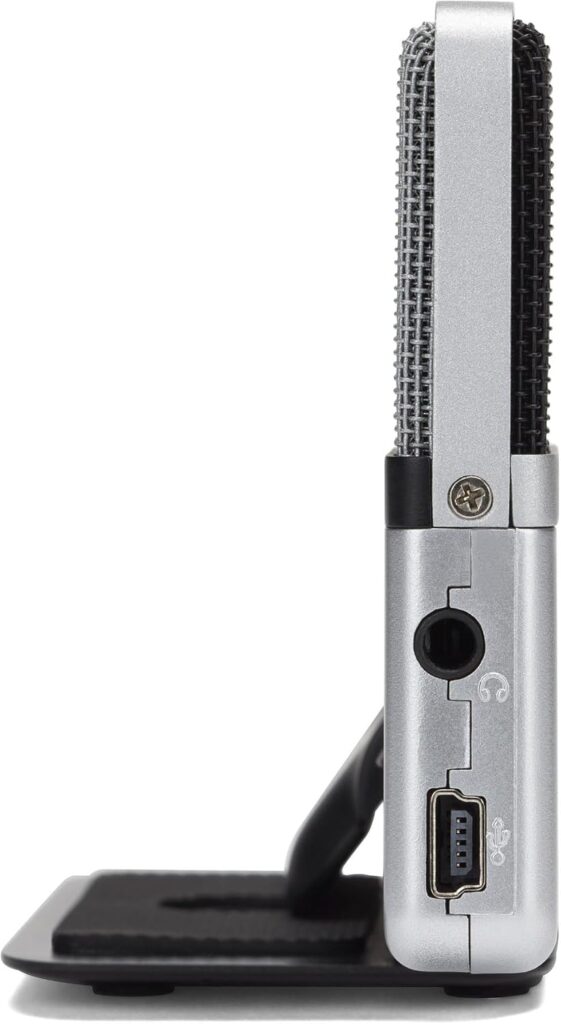Samson Go Review
The Samson Go Mic is a compact, portable USB condenser microphone that has garnered attention for its versatility, affordability, and ease of use. Released over a decade ago, it remains a popular choice for content creators, remote workers, musicians, and casual users looking to upgrade their audio quality without breaking the bank. In this review, we’ll dive deep into the Samson Go Mic’s design, features, performance, strengths, weaknesses, and its relevance in today’s market as of 2025. Whether you’re considering it for podcasting, video calls, streaming, or recording on the go, this article will help you decide if it’s the right fit for your needs.
Samson Go Mic Review
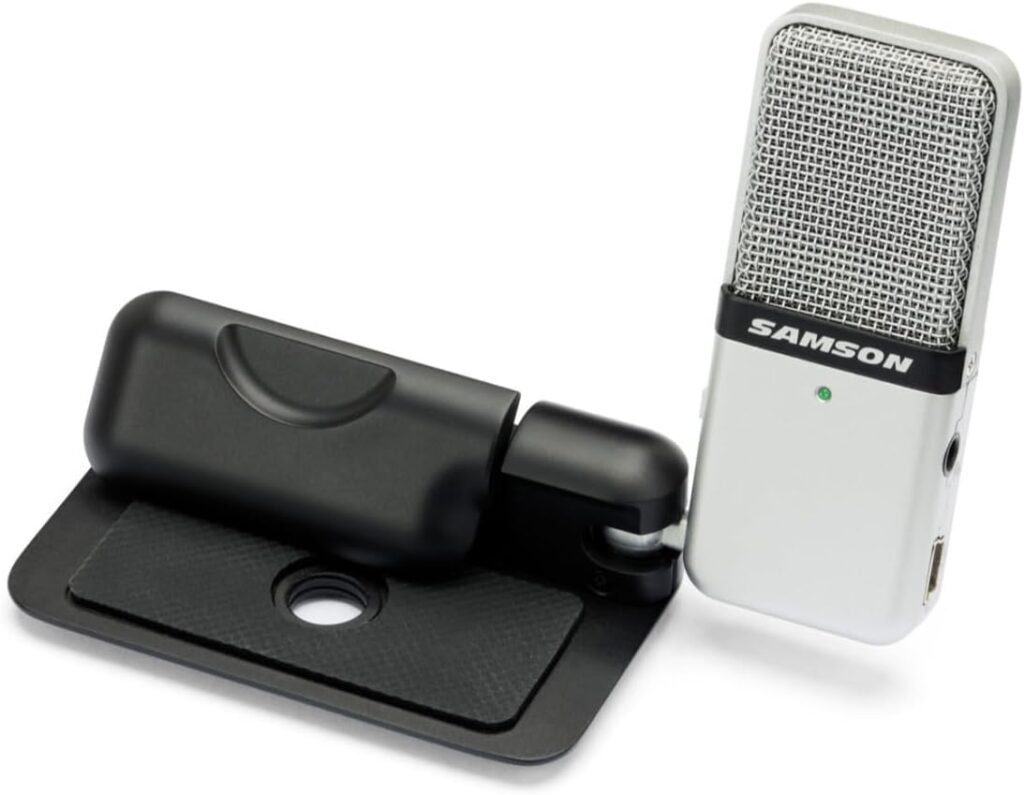
The Samson Go Mic is a USB condenser microphone designed with portability and simplicity in mind. Measuring roughly 2.8 x 1.7 x 0.9 inches and weighing just 3.7 ounces, it’s small enough to fit in your pocket or a laptop bag. Its unique fold-up design, combined with a sturdy clip, allows it to attach to a laptop screen, sit on a desk, or even mount onto a standard microphone stand (with an adapter). Priced typically around $40–$50, it’s an entry-level option that promises plug-and-play functionality and decent audio quality for a variety of applications.
Samson, a well-known name in the audio industry, markets the Go Mic as a solution for recording music, podcasts, field audio, or improving the sound quality of voice-over-IP (VoIP) calls like Zoom or Skype. It’s compatible with both Mac and Windows without requiring drivers, and it offers two polar patterns—cardioid and omnidirectional—along with a -10dB pad option, making it surprisingly feature-rich for its price point.
But does it hold up in 2025, with newer USB microphones flooding the market? Let’s break it down.
Design and Build Quality
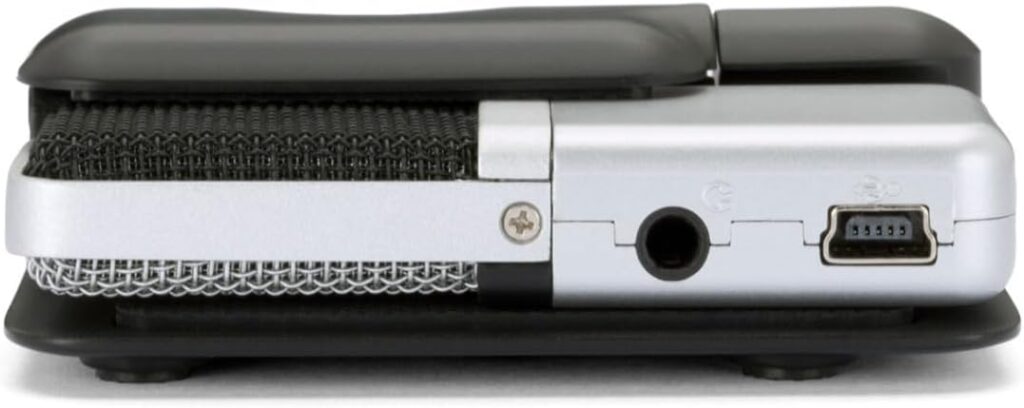
The first thing you notice about the Samson Go Mic is its size—or lack thereof. It’s about the size of a Bic lighter, making it one of the smallest USB microphones available. Despite its compactness, it doesn’t feel flimsy. The microphone body is made of metal, giving it a reassuring heft and durability that sets it apart from many plastic-heavy competitors in the same price range. The clip, which doubles as a stand, is also metal with a zinc-molded base, adding to the overall solid feel.
The fold-up design is a standout feature. The mic attaches to the clip via a swivel joint, allowing you to adjust its angle or fold it flat for storage. When folded, it fits neatly into a small zippered pouch (included in the box), which is no larger than a case for wireless earbuds. This portability is a huge plus for travelers, students, or anyone who needs a microphone that can go anywhere without taking up space.
On the mic itself, you’ll find a 3.5mm headphone jack for zero-latency monitoring, a mini-USB port for connection to your device, and a three-position switch on the side. This switch lets you toggle between cardioid mode (unidirectional), omnidirectional mode (360-degree pickup), and cardioid mode with a -10dB pad for louder sound sources. A small LED on the front glows green when powered and blinks red if the audio clips, providing a basic but useful visual cue.
However, the design isn’t flawless. The clip is strong but doesn’t open wide enough to attach securely to thicker desktop monitors, though it works well with laptops or thinner surfaces. The plastic hinge connecting the mic to the clip can feel like a potential weak point over time, and the included USB cable is short and not particularly high-quality. Some users opt to replace it with a right-angle cable for a cleaner setup.
Overall, the Samson Go Mic’s design strikes a balance between portability and practicality, with a build quality that exceeds expectations for its price.
Features and Specifications
For a budget microphone, the Samson Go Mic packs an impressive set of features:
- Polar Patterns: It offers two pickup patterns—cardioid and omnidirectional. Cardioid focuses on sound from the front, reducing background noise, while omnidirectional captures audio from all directions, ideal for group recordings or ambient sound.
- -10dB Pad: This reduces the mic’s sensitivity by 10 decibels, useful for loud voices or environments where clipping might occur.
- Frequency Response: In cardioid mode, it ranges from 80Hz to 18kHz; in omnidirectional mode, it widens to 20Hz to 20kHz, covering the full spectrum of human hearing.
- Sample Rate: It records at 16-bit/44.1kHz (or 48kHz in some configurations), which is CD-quality audio—adequate for most non-professional uses.
- Headphone Output: The 3.5mm jack allows real-time monitoring with no latency, a must-have for recording or live calls.
- Plug-and-Play: No drivers are needed, making it compatible with Mac, Windows, and even some mobile devices with the right adapter.
Inside, the Go Mic uses two 10mm back-electret condenser capsules, which are shock-mounted to reduce handling noise. Its maximum sound pressure level (SPL) is rated at 121dB, meaning it can handle relatively loud sources, especially with the pad engaged.
These specs make it versatile for its size and cost, but they also hint at its limitations. The frequency response, while decent, lacks the depth and clarity of higher-end mics, and the sample rate is standard but not exceptional. Still, for an entry-level device, it’s hard to ask for more.
Performance: How Does It Sound?
The Samson Go Mic’s audio quality is where it truly shines for its price range. It delivers crisp, clear sound that’s a significant step up from built-in laptop or phone microphones. Voices come through naturally, with minimal distortion, and the mic handles a variety of applications well.
- Cardioid Mode: In this setting, the mic focuses on the speaker’s voice while rejecting some ambient noise from the sides and rear. It’s ideal for solo podcasting, Zoom calls, or streaming. The sound is warm and full, though it can pick up plosives (pops from “p” and “b” sounds) if you’re too close without a pop filter.
- Omnidirectional Mode: This mode excels at capturing a room’s soundscape, making it great for interviews, group discussions, or field recordings. The wider frequency response (20Hz–20kHz) adds depth, though it also picks up more background noise, so placement is key.
- -10dB Pad: For louder sources—like a strong voice or an acoustic instrument—this setting prevents clipping effectively. It’s a thoughtful addition that enhances the mic’s flexibility.
In real-world tests, the Go Mic performs admirably for its intended audience. For Zoom calls, colleagues will notice a marked improvement over a laptop’s built-in mic, with less echo and better clarity. For podcasting or voiceovers, it’s serviceable, though it benefits from a pop filter (not included) and some post-processing to smooth out minor imperfections. Musicians can use it to record acoustic guitar or vocals in a pinch, but it’s not a replacement for a studio-grade condenser mic like the Audio-Technica AT2020 or Shure SM7B.
One downside is its sensitivity to ambient noise and vibrations. Without a shock mount beyond the internal capsule isolation, it can pick up desk taps or keyboard clicks if not positioned carefully. The lack of onboard gain control also means you’ll need to adjust levels via your recording software, which can be inconvenient.
Compared to other budget USB mics like the Blue Snowball or Fifine K669B, the Go Mic holds its own. It doesn’t have the Snowball’s richer low-end or the Fifine’s aggressive noise rejection, but its portability and dual polar patterns give it an edge for mobile users.
Setup and Compatibility
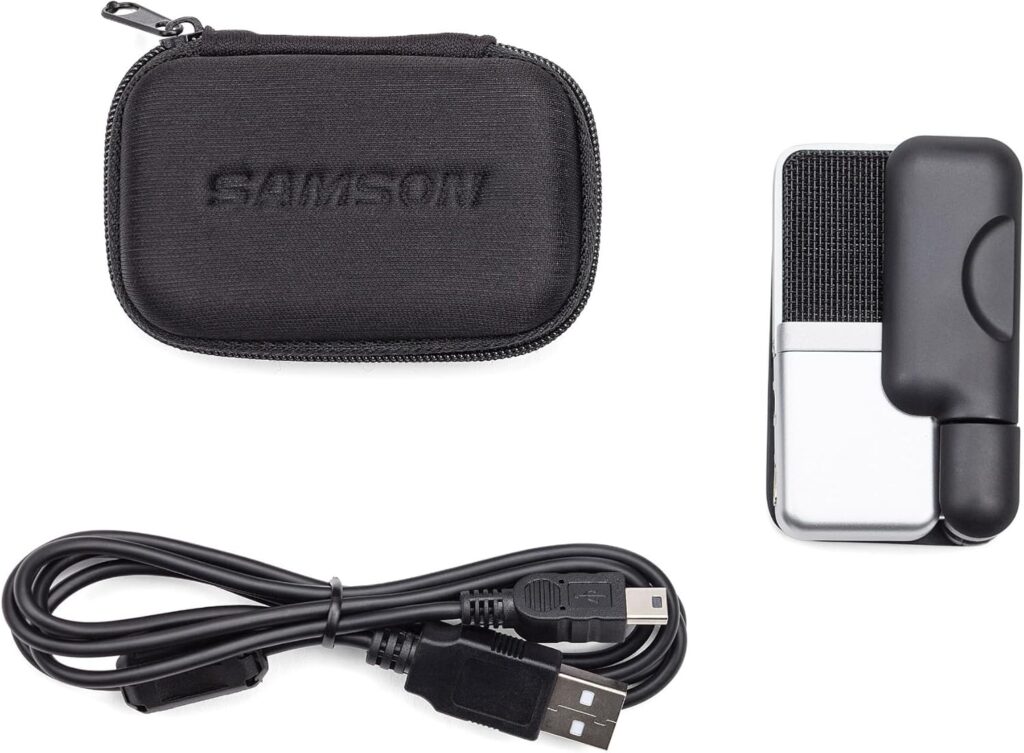
Setting up the Samson Go Mic is a breeze. Plug it into a USB port, and it’s ready to go—no software or drivers required. On Windows and Mac, it’s recognized instantly as an audio input and output device (for headphone monitoring). You can use it with popular software like Audacity, GarageBand, OBS, or Zoom without issue.
For mobile use, it works with iPads or Android devices via a USB adapter (not included), though compatibility can vary depending on the device and app. Some users report a slight delay in recognition (1–2 minutes) on certain systems, and rare connection issues have been noted, particularly with older units or Windows 8.1.
The headphone output is a standout feature, offering zero-latency monitoring that’s essential for recording or live communication. However, using it as your computer’s default output device can strain the circuitry over time, so it’s best to route audio through your system’s speakers instead.
Strengths and Weaknesses
Strengths:
- Portability: Its tiny size and fold-up design make it unbeatable for travel or small setups.
- Versatility: Dual polar patterns and a -10dB pad cater to a range of recording needs.
- Affordability: At $40–$50, it’s a steal for the features and sound quality.
- Build Quality: The metal construction feels durable and premium for the price.
- Ease of Use: Plug-and-play simplicity is perfect for beginners.
Weaknesses:
- No Pop Filter: It’s prone to plosives, requiring an external filter for optimal vocal recording.
- Limited Noise Rejection: It picks up ambient sounds easily, especially in omnidirectional mode.
- No Gain Control: Adjusting input levels requires software tweaks.
- Clip Limitations: The clip struggles with thicker surfaces, and the hinge may wear out.
- Not Studio-Grade: It’s great for casual use but lacks the fidelity of pricier mics.
Who Is It For?
The Samson Go Mic is ideal for:
- Remote Workers: Perfect for Zoom or Skype calls with better audio than built-in mics.
- Beginner Podcasters/Streamers: A solid starter mic that’s easy to use and transport.
- Students: Compact and affordable for recording lectures or group projects.
- Traveling Creators: Vloggers or musicians needing a lightweight audio solution.
It’s less suited for:
- Professional Recording: Studio engineers will want higher fidelity and control.
- Noisy Environments: Its sensitivity requires a quiet space for best results.
Relevance in 2025
Despite its age, the Samson Go Mic remains relevant in 2025. The rise of remote work, streaming, and portable content creation has kept demand high for affordable, compact audio solutions. While newer USB mics offer RGB lighting, higher sample rates, or built-in DSP, the Go Mic’s simplicity and reliability keep it competitive. It’s not cutting-edge, but it doesn’t need to be—it delivers on its promise without unnecessary frills.
Compared to alternatives like the HyperX SoloCast ($60) or Rode NT-USB Mini ($99), it’s less polished but more portable and cheaper. For users prioritizing mobility over advanced features, it’s still a top contender.
The Bottom Line
The Samson Go Mic is a little powerhouse that punches above its weight. Its combination of portability, versatility, and solid audio quality makes it a fantastic value for under $50. It’s not perfect—lacking a pop filter, onboard gain, and robust noise isolation—but these are minor trade-offs for its size and cost.
In 2025, it’s a worthy investment for anyone needing a reliable, travel-friendly microphone without the complexity or expense of professional gear. If you’re starting a podcast, upgrading your video calls, or dabbling in audio recording, the Samson Go Mic is a practical, no-nonsense choice that gets the job done. Just don’t expect it to rival a $200 studio mic—it’s built for convenience, not perfection.

